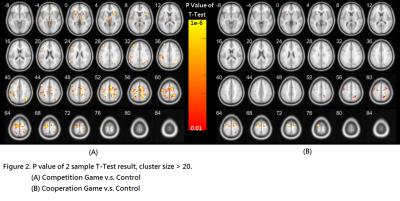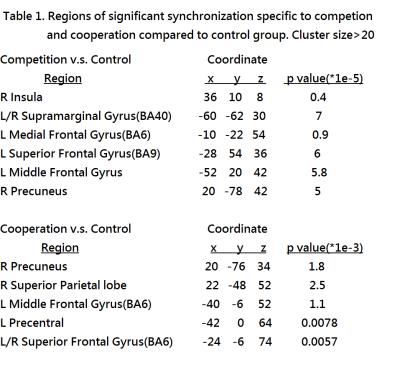5284
The Synchronization of Brain Activity in Real-Time Human Interaction Revealed by fMRI Hyperscanning1Graduate Institute of Biomedical Electronics and Bioinformatics, National Taiwan University, Taipei, Taiwan, 2College of Humanities and Social Sciences, Taipei Medical University, Taipei, Taiwan, 3Institute of Neuroscience, National Yang-Ming University, Taipei, Taiwan, 4Institute of Biomedical Engineering, National Taiwan University, Taipei, Taiwan, 5Department of Neuroscience and Biomedical Engineering, Aalto University, Espoo, Finland
Synopsis
This study used functional magnetic resonance imaging (fMRI) hyperscanning to estimate the synchronization of human brain activations in interpersonal interaction by inter-subject correlation (ISC) analysis. Brain activations of pairs of subjects were recorded simultaneously during real-time video tennis game under cooperation, competition, and a control condition involving no interaction. Compared to control condition, higher ISC was found in premotor area (BA6) and right precuneus in the two game conditions. The finding of premotor area suggests that mutual action understanding was supported by the mirror neuron system during interpersonal interaction.
TARGET AUDIENCE
Researchers interested in hyper scanning fMRI of human interaction.INTRODUCTION
Great success has been made by functional magnetic resonance imaging (fMRI) to non-invasively localize functional areas sensitive to specific perception, cognitive processing, and behavior planning/execution when participants are isolated and presented with well-controlled stimuli. Recent fMRI experiments start to study the correlated brain activity across subjects1 or to decode the physical and subjective preceptions2 using complex and naturalistic stimuli3, yet the neural correlates directly related to inter-subject social interaction in naturalistic contexts still remain largely unknown. This project aims to investigate the neural dynamics underlying real-time interpersonal interaction in an ecological valid setting.
Human can adjust themselves to synchronize to social group in a very short time. For example, people in conversation often synchronize their tempo of speech, wording, and even syntactic structure4. Also, people in the same space tend to synchronize their movement5. These examples demonstrate that the effects of interpersonal interaction could be strong, automatic, and might induce a quick change in the brain in terms of seconds or even shorter. Therefore, hyperscanning fMRI technique which allows the measurement of brain activities with a reasonable temporal and spatial resolution, is highly beneficial to the investigation of the neural dynamics underlying real-time interpersonal interaction.
Interpersonal interaction involves reactions to the others. Reaction could be based on the action or our understanding of the action of the others. We hypothesize that mutual understanding during interpersonal interaction would be reflected by cross-brain synchronization and used interactive tennis game to examine our hypothesis.
METHODS
Eight pairs of healthy volunteers from age 22 to 34 joined this experiment. Two subjects were scanned simultaneously in two separate 3T SIEMENS MR scanners (Tim Trio and Skyra) with a 32-channel head coil array (Figure 1A) using the same echo-planar imaging (EPI) sequence (TR = 2000ms, TE = 26ms, and the matrix size = 64*64*40, isotropic 4mm voxel size).
Each subject went through six sessions, and each sessions lasted for 7mins 20secs. In four sessions, subjects played tennis game (Tennis Elbow 2013 on STEAM) using a customized MR-compatible gamepad inside the MR scanner (Figure 1B). There were always four players on the court, two controlled by the subjects and two controlled by computer. The two subjects were opponents in two sessions, and were teammates in the other two sessions. Screen and keypress responses were recorded. The rest two sessions were control condition, in which subjects were required to watch videos of tennis game and follow the designated character’s movement with the gamepad. These videos were made based on videos recorded from the previous players by removing the tennis ball and its trajectory. We also combined the upper part (above the net) of one video and the lower part of another video, so merely little interaction between characters were involved in control condition. The designated characters were teammates in one control session, and were opponent in the other control session. Session order was counter-balanced across pairs.
EPI data from each pair of subjects were first preprocessed with SPM, including normalization to the MNI template. The synchronization between two players was estimated by calculating the inter-subject correlation6 (ISC). Pearson correlation coefficient between two time series data at the same voxel of two brains was computed. Fisher’s-z transformation then was applied to the correlation coefficients. T-test was used to compare the game and the control condition.
RESULT
As shown in Figure 2 and Table 1, compared to control condition, both game conditions, which involved actively participating in game and interpersonal interaction, revealed significant high ISC in premotor area (BA6) and right precuneus. Under the competition condition, significant high ISC was also found in left middle frontal gyrus (MFG), thalamus, and right insula.Discussion & Conclusion
Compared to control condition, higher ISC was found in premotor area and right precuneus under game conditions which suggested that active participation and interpersonal interaction increased the cross-brain synchronization. Specifically, BA6 has been reported to be part of the human mirror neuron system7. Mirror neuron activates both during self-action and the other’s action8. Our finding of BA6 is consistent with theory suggesting that mirror neuron system serves not only action imitation but also action understanding9. Direct comparison between the two game conditions is expected to further reveal how different types of interpersonal interaction differ in cross-brain synchronization.Acknowledgements
This work was partially supported by Ministry of Science and Technology, Taiwan (103-2628-B-002-002-MY3, 105-2221-E-002-104), and the Academy of Finland (No. 298131).References
1. Hasson, U. (2004), 'Intersubject Synchronization of Cortical Activity During Natural Vision'
2. Nishimoto, S. et al. (2011), 'Reconstructing visual experiences from brain activity evoked by natural movies'
3. Bartels, A. & Zeki, S. (2004), 'Functional brain mapping during free viewing of natural scenes'
4. Garrod, S., & Pickering, M. J. (2004). Why is conversation so easy? Trends in Cognitive Sciences
5. Repp, B. H., & Su, Y.-H. (2013). Sensorimotor synchronization: a review of recent research (2006-2012)
6. Pajula, Kauppi, Tohka (2012) Inter-Subject Correlation in fMRI: Method Validation against Stimulus-Model Based Analysis
7. Cattaneo, L., & Rizzolatti, G. (2009). The mirror neuron system.
8. Gallese, V., Fadiga, L., Fogassi, L., Rizzolatti, G., Umana, F., Parma, U., & Rizzolatti, G. (1996). Action recognition in the premotor cortex.
9. Keysers, C., & Perrett, D. I. (2004). Demystifying social cognition: a Hebbian perspective.

